A flash of bright blue feathers may make a bird easier to spot among the trees and shrubbery, but the magnificent color blends seamlessly with the sky. If you happen to see one, you won’t forget the beautiful plumage. Here are ten of our favorite blue birds and how to find them.
10 Blue Bird Species
1. Blue Grosbeak
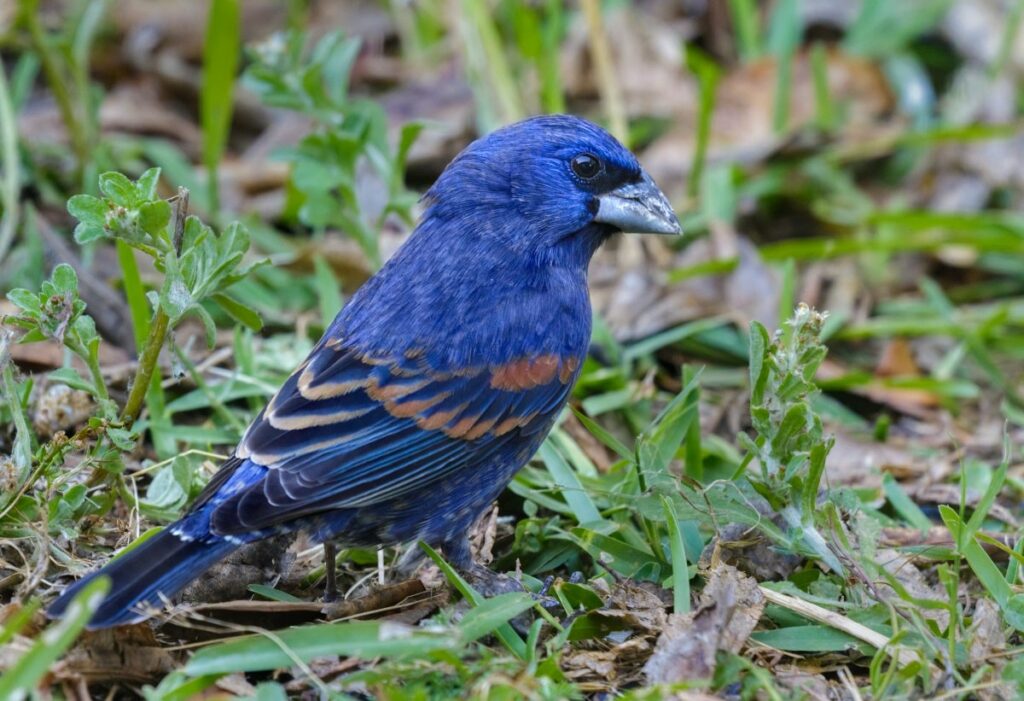
- Scientific Name: Passerina Caerulea
- Size: 5.9 to 6.3 inches
- Weight: 0.9 to 1.1 ounces
- Wingspan: 11 inches
Preferring warmer climates, blue grosbeaks are native to Mexico and the Caribbean islands but can be seen in the southern United States during the breeding season. Though woodlands are their go-to areas for breeding, blue grosbeaks make homes in shrubbery along waterways.
The female of a blue grosbeak pairing will build the cup-shaped nest in low shrubs or trees up from three to ten feet in the air. Once she is ready, the blue grosbeak female will have three to five eggs twice per year.
Though blue grosbeaks tend to breed in more open areas, they aren’t opposed to using bluebird nest boxes and have been seen to on at least one occasion.
2. Blue Jay
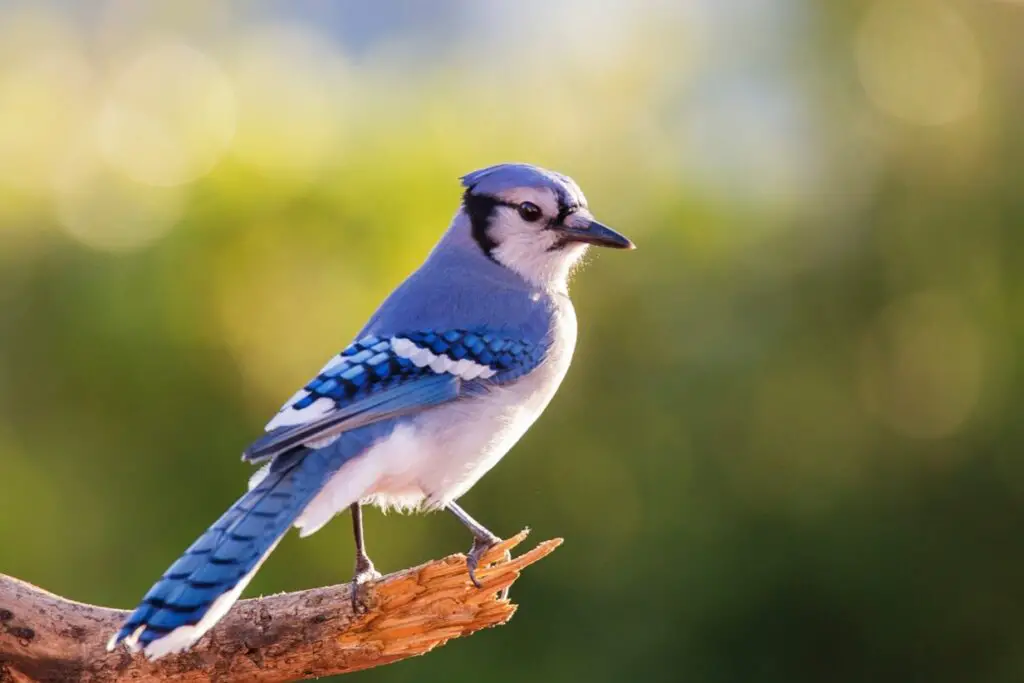
- Scientific Name: Cyanocitta Cristata
- Size: 9.8 to 11.8 inches
- Weight: 2.5 to 3.5 ounces
- Wingspan: 13.4 to 16.9 inches
Commonly known to the United States, the blue jay can be found in all of the states east of the Mississippi River as well as most northern states and southern parts of Canada. Preferential to trees, blue jays like forest edges and woodlots but can also be found in cities and towns.
Both sexes of a mating pair help build their bulky cup nest that sits in the fork of tree limbs between eight and thirty feet in the air. Female blue jays will have four to five eggs in their one brood per year. (Some southern blue jays will have two broods per year.)
The black bridles along a blue jay’s face, throat, and nape of the neck are as varied as human fingerprints and may help other blue jays recognize each other.
3. California Scrub Jay
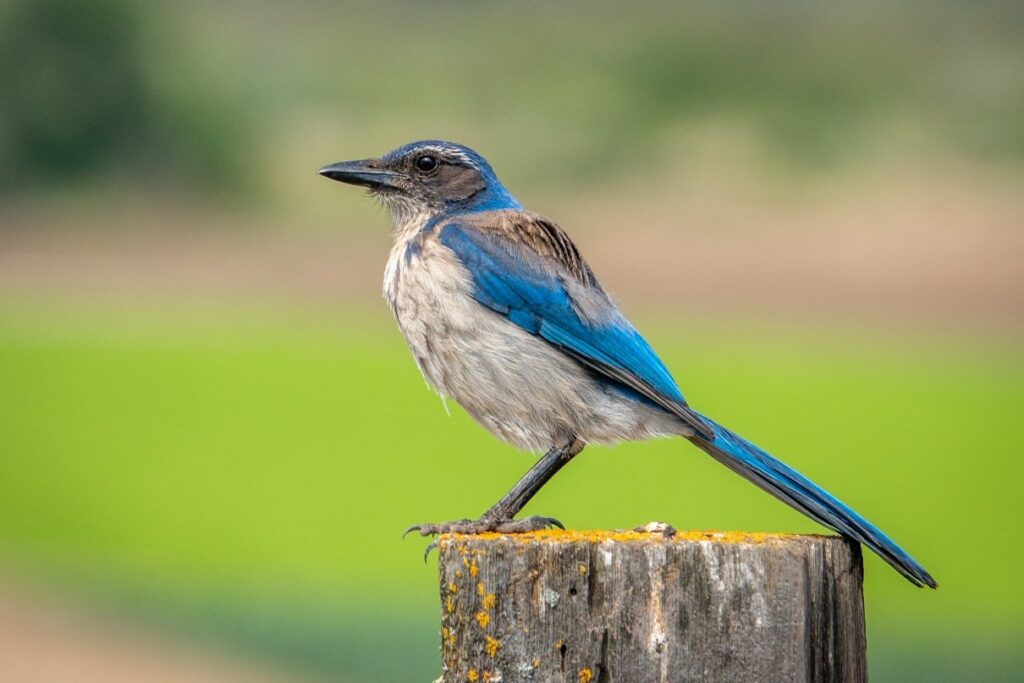
- Scientific Name: Cyanocitta Cristata
- Size: 11 to 11.8 inches
- Weight: 2.5 to 3.5 ounces
- Wingspan: 15.3 inches
As their name suggests, California scrub jays are native to the western coast of the United States—predominately California—and the Baja California peninsula of Mexico. California scrub jays prefer lower and drier habitats like oak woodlands, backyards, and pastures.
Sticking lower to the ground, both sexes of the California scrub jay will build their thick, cup-shaped nest from five to fifteen feet above the ground in shrubs or trees. The female will then have two to seven (typically three to five) eggs in their yearly brood.
California scrub jays and mule deer have a symbiotic relationship where the California scrub jay can be seen standing on the back of the mule deer eating ticks from their fur.
4. Cerulean Warbler

- Scientific Name: Setophaga Cerulea
- Size: 4.3 inches
- Weight: 0.3 ounces
- Wingspan: 7.9 inches
Cerulean warblers can be found in northern South America and along the northwestern portion of the Andes Mountains. They also breed along the eastern coast of Mexico and in some southern and Midwest states in the United States. They mainly like forests and open understory.
The female of a breeding pair most likely builds the nest anywhere from fifteen to ninety feet in the air on a horizontal branch away from the trunk of the tree. Then, the female will have three to five eggs in her annual brood.
After sitting on the nest for a while, a female cerulean warbler will drop from the side of the nest and keep her wings folded in until she spreads them to fly when she is sufficiently below the nest.
5. Indigo Bunting
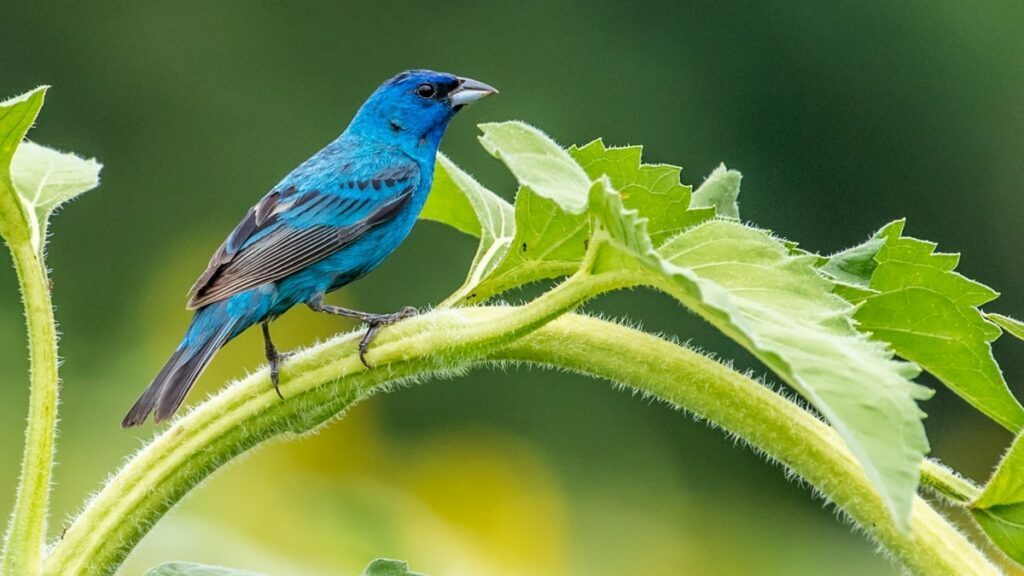
- Scientific Name: Passerina Cyanea
- Size: 4.7 to 5.1 inches
- Weight: 0.4 to 0.6 ounces
- Wingspan: 7.5 to 8.7 inches
Primarily seen in the middle to southern portions of Mexico and the Caribbean, the indigo bunting will breed in eastern portions of the United States occasionally seen in Nevada, Utah, Colorado, Arizona, and New Mexico. They prefer to make their homes in weedy or bushy areas like where forests meet field edges.
The open nest cup that is built by the female is placed only around one to three feet up in a dense bush or low tree. A female indigo bunting will have one to four eggs in her twice-a-year broods.
Indigo buntings migrate at night using an internal clock that allows them to follow one star continually, even if it moves through the night sky.
6. Mountain Bluebird
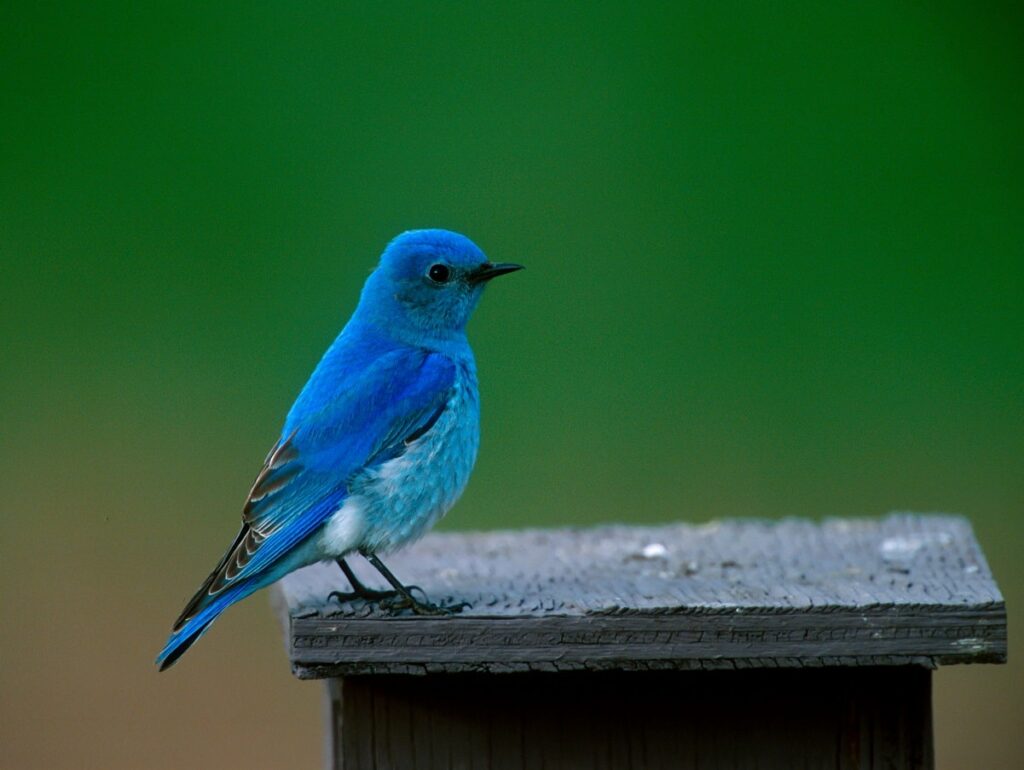
- Scientific Name: Sialia Currucoides
- Size: 6.3 to 7.9 inches
- Weight: 1.1 ounces
- Wingspan: 11 to 14.2 inches
As the name suggests mountain bluebirds like to make homes in middle to high elevations in wide-open plains. They tend to gravitate toward the southwestern United States and the northwestern portion of Mexico to live and northwestern North America for breeding.
The female mountain bluebird picks the site for the nest to be built and both of the sexes build them together in some kind of cavity in the ground or a tree. When the time comes, the female will have four to eight eggs in her two annual broods.
Where their paths overlap, mountain bluebirds will sometimes breed with eastern bluebirds making hybrid species.
7. Pinyon Jay

- Scientific Name: Gymnorhinus Cyanocephalus
- Size: 10.2 to 11.4 inches
- Weight: 3.2 to 4.2 ounces
- Wingspan: 18.1 inches
Pinyon jays are native to the southwestern United States including Nevada, Utah, Idaho, Wyoming, Colorado, Arizona, New Mexico, California, and Montana. They like to make their homes in forests and other shrubby areas.
Both of the parents help build the nest around three to twenty feet up in some sort of tree of their choosing. The female pinyon jay will have three to six eggs in her annual brood.
Once hatched, a pinyon jay may spend its whole life in the colony it was born to as it can grow to be large enough to support five hundred pinyon jays.
8. Satin Bowerbird
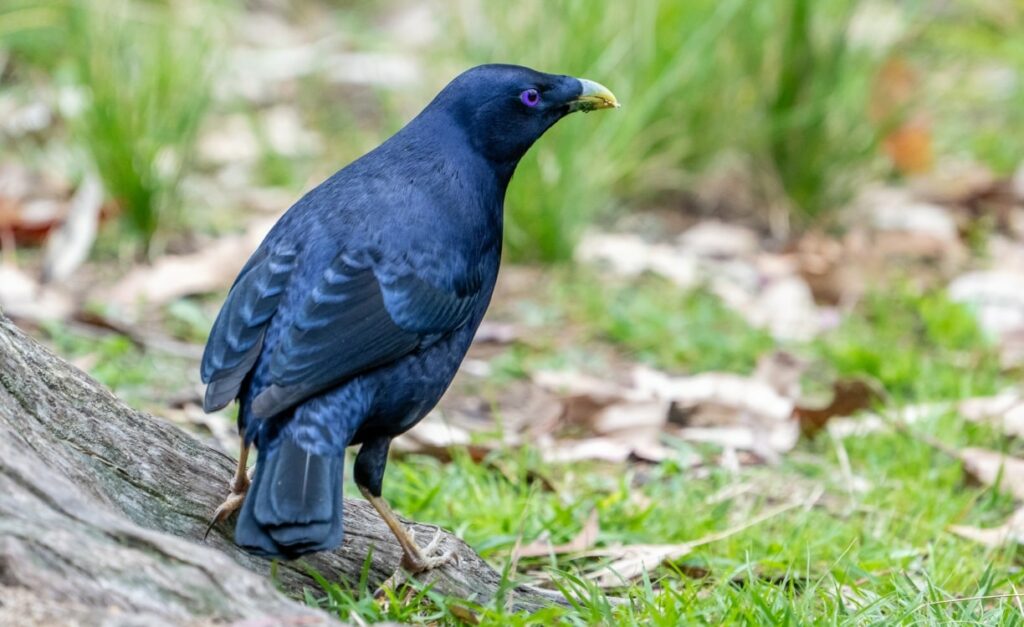
- Scientific Name: Ptilonorhynchus Violaceus
- Size: 10.6 to 13.7 inches
- Weight: 5.9 to 10.2 ounces
- Wingspan: 18 to 20 inches
This stunning dark blue bird is found along the eastern coast of Australia with the majority of the population ranging from Brisbane to Melbourne. The satin bowerbird prefers wet forests with neighboring open lands while some even make their homes in rainforests.
Alone, the female makes a loose cup-shaped nest of twigs and places it close to one hundred feet up in a tree. She will have one to three eggs in her once-per-year brood.
To attract the attention of a female, the male satin bowerbird will gather twigs and colorful trinkets (ones that he finds and ones that he may dye with blueberry juice) and uses his architecture skills to arrange them just so.
9. Steller’s Jay

- Scientific Name: Cyanocitta Stelleri
- Size: 11.8 to 13.4 inches
- Weight: 3.5 to 4.9 ounces
- Wingspan: 17.3 inches
Commonly found along mountain ranges in the western portion of North America, specifically, the Rocky Mountains in the United States, the steller’s jay prefers heights of 3,000 to 10,000 feet. Often seen at campgrounds and parks, steller’s jays are not afraid of people.
The bulky, cup-shaped nest that is built by both sexes is usually placed from ten to thirty feet up in a tree of their choosing. Female steller’s jays will have two to six eggs in their annual brood.
Being the only two North American jays with crests, steller’s jays and blue jays often interbreed to create hybrid species.
10. Tree Swallow
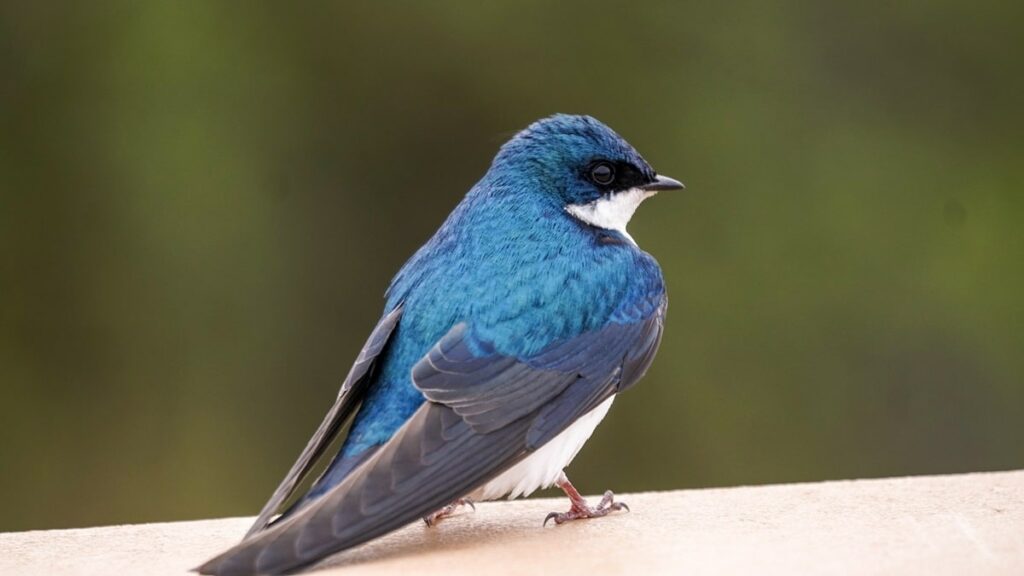
- Scientific Name: Tachycineta Bicolor
- Size: 4.7 to 5.9 inches
- Weight: 0.6 to 0.9 ounces
- Wingspan: 11.8 to 13.8 inches
Mostly seen in Mexico and the Caribbean, the tree swallow breeds across the United States and much of Canada. Being quite fond of water, tree swallows like to make their homes in fields near wetlands or waterways.
The nests, built mostly by the female tree swallow, are usually in the cavity of a tree. Sometimes tree swallows will even use nest boxes to host their two to eight eggs in their once-per-year brood.
Like many swallows, tree swallows make a unique shape with their colony. Colonies that migrate or winter together can range from one hundred to a couple thousand birds that gather just before sunset and swirl in a dense cloud above their roosting spot.
